Food can reflect culture, but can food also reflect history?
That was what Lee Chi-lin (李其霖), associate professor of history at Tamkang University (淡江大學) wanted to explore when he gathered historians, local officials and culinary enthusiasts at the Tamsui Red House (淡水紅樓), an exquisite red-brick Taiwanese cuisine restaurant built in 1899.
Lee planned the menu to reflect the historic Qing victory over the French in the Battle of Tamsui, also known as the Battle of Hobe (滬尾, Tamsui’s old name).
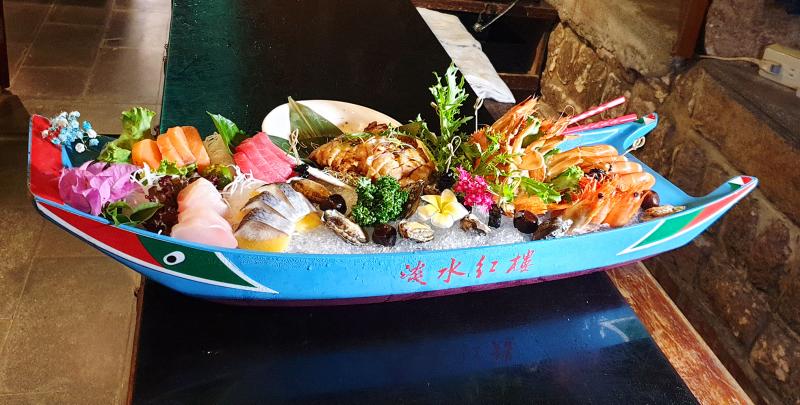
Photo: Katy Hui-wen Hung
On Aug. 23, 1884 war had broken out due to a territorial dispute in Vietnam between the French and Taiwan’s Qing Dynasty overlords.
After capturing Keelung, French warships appeared just outside Tamsui in early morning of Oct. 2 and bombarded the port. The French Fusiliers Marins launched a ground assault on Oct. 8, but defending forces drove out the invaders in just four hours.
The French defeat played a significant role in the Qing’s recognition of the strategic importance of controlling Taiwan and the imperial decision to separate Taiwan from Fujian as its 20th province in 1885.
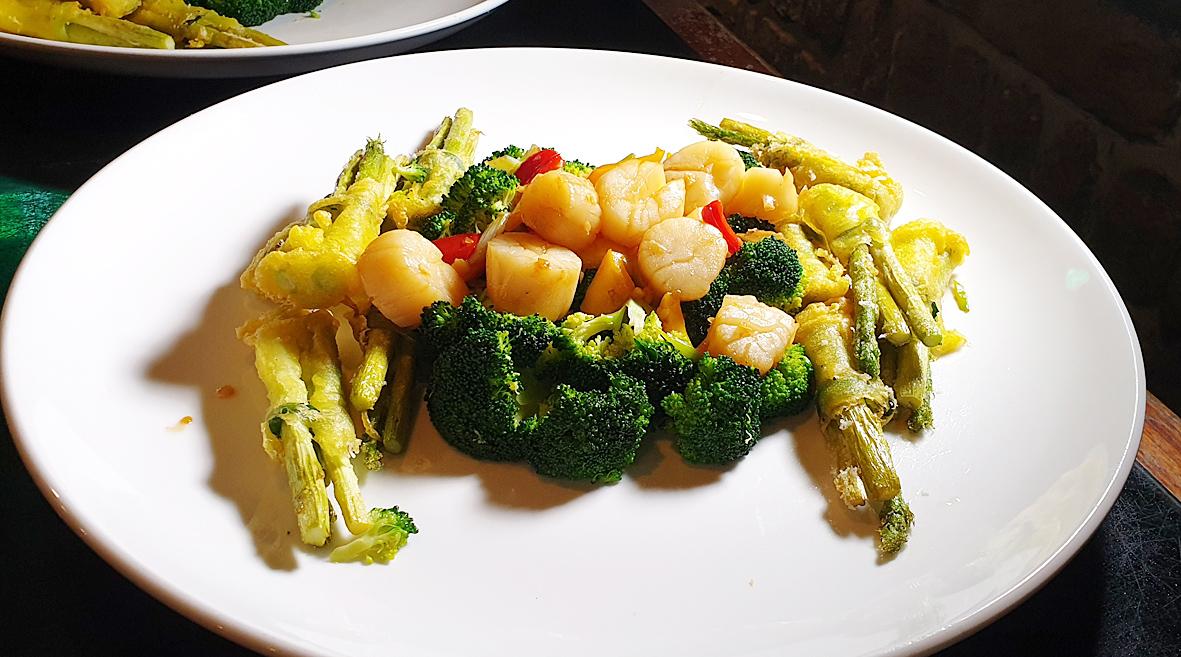
Photo: Katy Hui-wen Hung
Lee’s 10-course menu illustrated significant aspects of the event. In battle storytelling fashion, Lee described each dish before it was served on the tables. However, gastronomic concerns over the order of the dishes took preference over the exact chronology.
Dish 1
“Reveille:” The call to battle begins with a beautifully decorated local seafood boat. The French coveted the port of Tamsui, regarded as a stronghold of maritime trade since the 17th century. Heavily armed, the invaders are represented by a large crab. The Qing, poorly equipped but numerous, are the smaller prawns. And an uninvited Japanese admiral, Heihachiro Togo, watches while eating sashimi on the battlecruiser Amagi. Black beans and iron eggs (a Tamsui specialty) depict planted spies, including a British pilot named Bentley, who went by the Italian name Carozzi.

Photo: Katy Hui-wen Hung
Dish 2
“Hobe Coastal Defense:” The local effort to fend off the invaders is presented by a mixed vegetable dish cooked with the popular French ingredients of scallops and asparagus. The asparagus tempura is arranged to resemble the 2km to 3km long fortification that locals built for the Qing army. Broccoli represents the grassy path to the battlefield and peppers the mangroves.
Dish 3
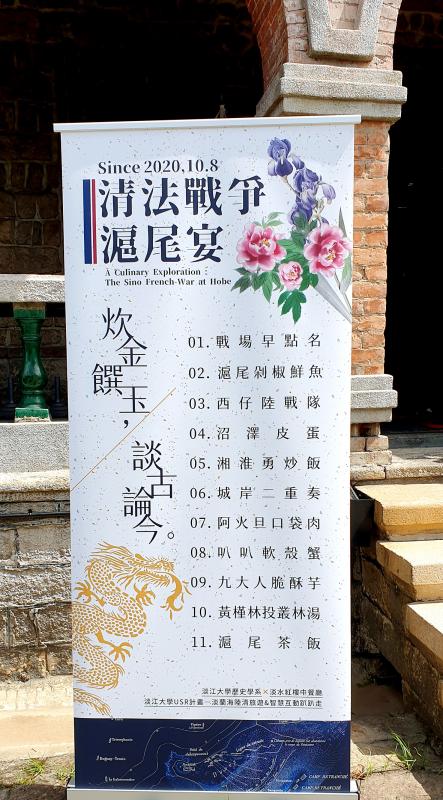
Photo: Katy Hui-wen Hung
“Crossing the Swamp:” This malabar spinach based “thick soup” made with finely chopped preserved eggs, pork, wolfberry and dried fish delivers both flavor and aesthetics. The green soup portrays the intense battlefield and the swampy land covered in paddy fields. Failing to diffuse the Qing’s naval mines, the French made a quick retreat in a boat shown by a flower in a small glass vase in the center of the dish.
Dish 4
“A-ho-da (阿火旦)” pocket meat: Local militia leader Chang Li-cheng (張李成) gathered about 500 Hakka and Aboriginal warriors (who were documented shooting flintlock rifles lying down with the barrel between their toes), pocketing a hard-won victory, hence the braised pork belly in steamed pancake pockets. Chang’s nickname A-ho-da is reportedly an amalgamation of his fiery temperament and his playing of female roles in traditional opera troupes.
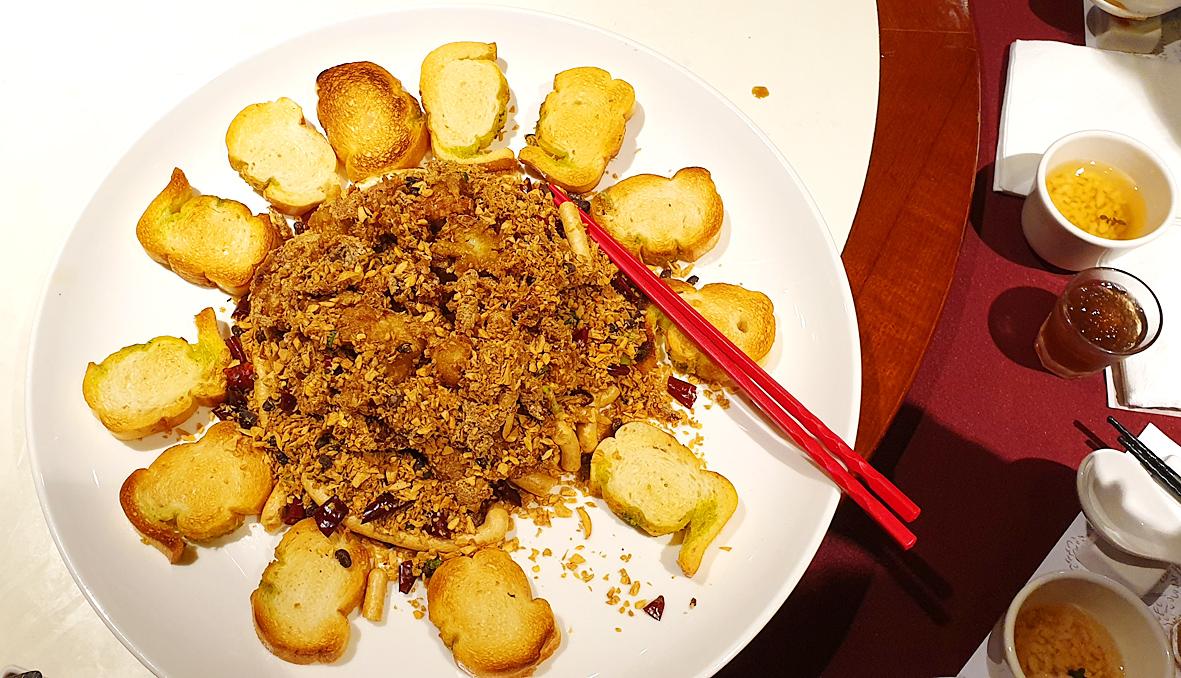
Photo: Katy Hui-wen Hung
Dish 5
“Ba-ba softshell crab:” A heap of fried garlic, ginger and chili surrounded by a circle of toasted bread paints the panicking French encircled by the Qing army. Ba-ba, which approximates the sound of a bugle, refers to the wounded bugler who was unable to deliver the French commander’s orders to ease-up firing and conserve ammunition. The French soldiers’ knees buckled and their legs trembled with fear. Like a softshell crab, they accepted defeat and started to retreat.
Dish 6
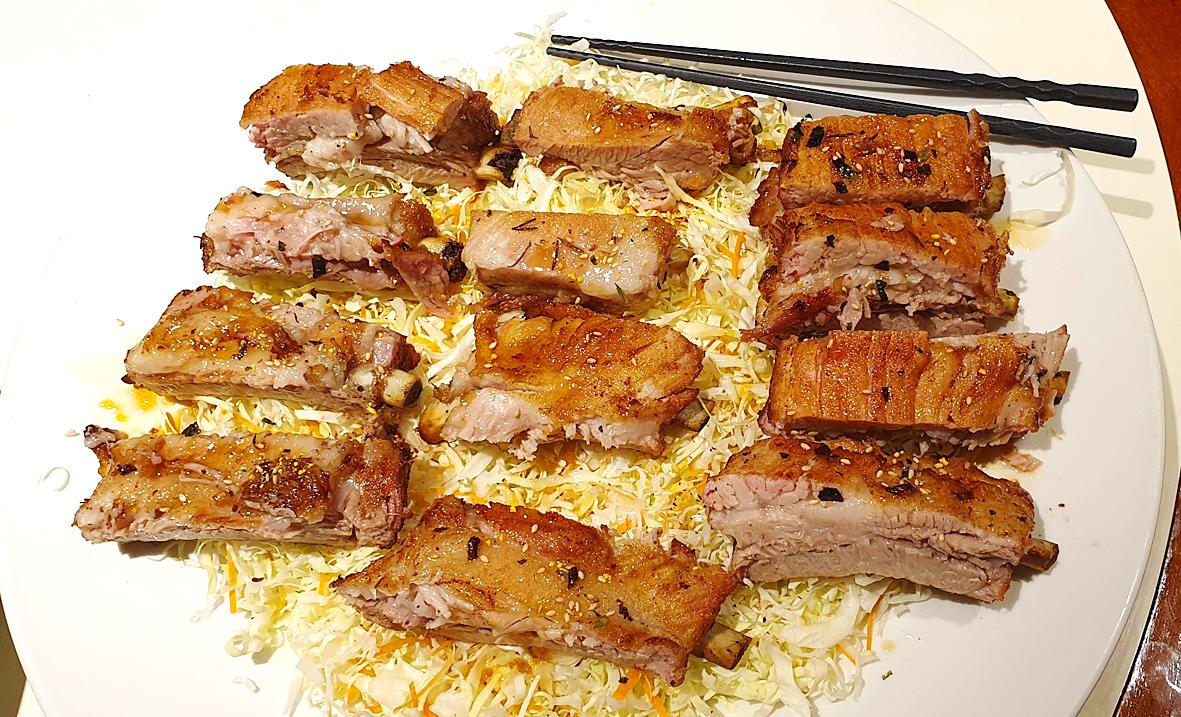
Photo: Katy Hui-wen Hung
Ribs with dijon mustard on cabbage: Upon landing on Shalun Beach (沙崙), the French forces were neatly arranged in lines of 10 squadrons and companies. The ribs are marinated in French mustard and served on shredded cabbage.
Dish 7
Bass with chopped chili: This creation represents the French hopes of catching a fresh fish (Tamsui) only to be taught a bitter lesson, repulsed by the mountains of obstacles (chili) the defenders built.
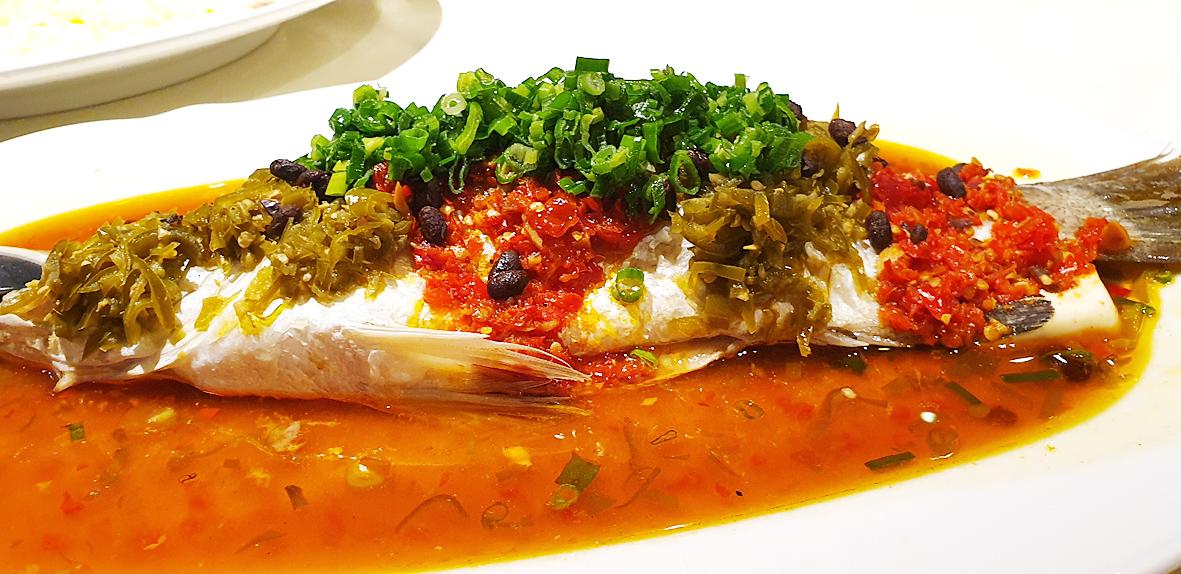
Photo: Katy Hui-wen Hung
Dish 8
“Xiang Army fried rice:” Troops from the Qing’s Xiang (Hunan Province) and Huai (Anhui Province) armies were in charge of defending Taiwan. This tumeric rice dish includes General Tso chicken representing the Xiang and cranberry the Huai, and black sesame the hardy Hunan yong (勇, brave) warriors. It’s said that even the severely wounded yong rushed straight back to the battlefield after being patched up at the local Mackay Clinic, founded by renowned Canadian missionary George Leslie Mackay.
Dish 9

Photo: Katy Hui-wen Hung
“Mangrove soup:” Soon after landing at Shalun Beach, the low growing thorny mangrove bushes and sharp edged screwpines disoriented the French and hindered their advance. These two natural defensive plants form the idea behind the clear soup: Yellow dried daylily and white wood ear fungus represent the screwpine and mangroves, respectively, due to their shapes.
Dish 10
“General’s crispy taro:” The final dish pays tribute to General Sun Kai-hua (孫開華), who led the successful defense of Tamsui. However, Qing imperial commissioner Liu Ming-chuan (劉銘傳), who failed to defend Keelung, tried to steal Sun’s thunder by claiming victory for himself and his faction in official reports, even accusing Sun of dereliction of duty. Taro was reportedly Sun’s favorite food and an important staple in both Tamsui and Sun’s hometown in Hunan. It is served deep-fried, coated in peanut and sesame.
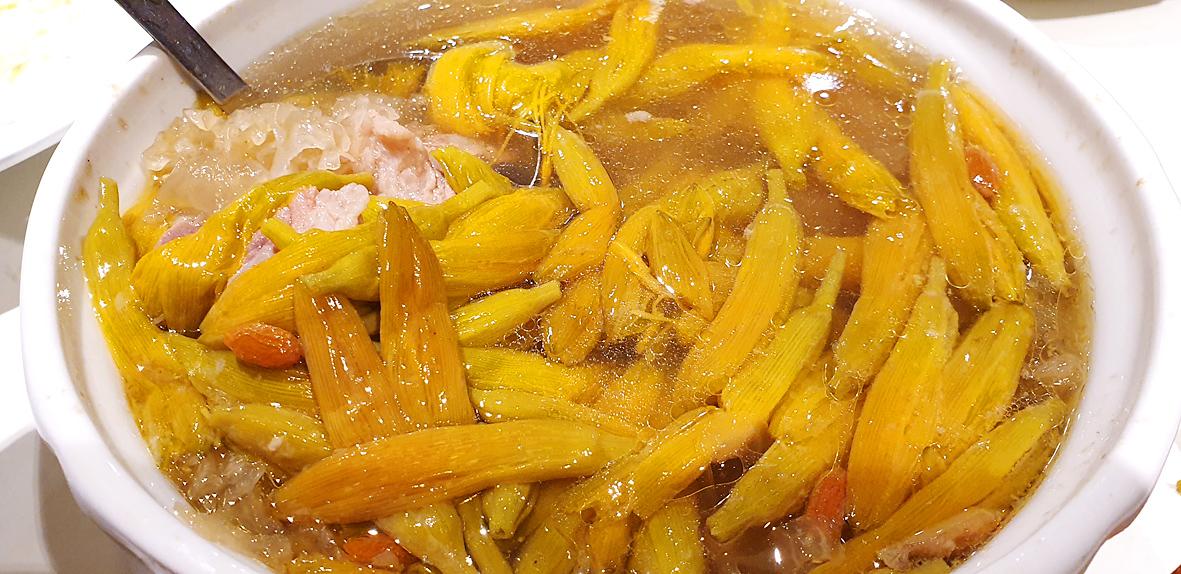
Photo: Katy Hui-wen Hung
TEA INSTEAD OF WINE?
“Hobe tea rice” is a local staple that locals enjoyed in 1884, Lee explains.
It is typically served in a bowl of brown indica rice, which is good for digestion, with tea poured in just before serving.
At the beginning of the banquet, a symbolic tablespoon of polished white rice in a small cup of oolong tea was offered, with tea served throughout the affair.
French gourmands would probably question why wine was not served. The heroic General Sun would too, as he was a known wine lover who was reportedly seen sipping champagne leisurely in the shade of a tree during the French bombardment.

April 14 to April 20 In March 1947, Sising Katadrepan urged the government to drop the “high mountain people” (高山族) designation for Indigenous Taiwanese and refer to them as “Taiwan people” (台灣族). He considered the term derogatory, arguing that it made them sound like animals. The Taiwan Provincial Government agreed to stop using the term, stating that Indigenous Taiwanese suffered all sorts of discrimination and oppression under the Japanese and were forced to live in the mountains as outsiders to society. Now, under the new regime, they would be seen as equals, thus they should be henceforth

Last week, the the National Immigration Agency (NIA) told the legislature that more than 10,000 naturalized Taiwanese citizens from the People’s Republic of China (PRC) risked having their citizenship revoked if they failed to provide proof that they had renounced their Chinese household registration within the next three months. Renunciation is required under the Act Governing Relations Between the People of the Taiwan Area and the Mainland Area (臺灣地區與大陸地區人民關係條例), as amended in 2004, though it was only a legal requirement after 2000. Prior to that, it had been only an administrative requirement since the Nationality Act (國籍法) was established in

With over 80 works on display, this is Louise Bourgeois’ first solo show in Taiwan. Visitors are invited to traverse her world of love and hate, vengeance and acceptance, trauma and reconciliation. Dominating the entrance, the nine-foot-tall Crouching Spider (2003) greets visitors. The creature looms behind the glass facade, symbolic protector and gatekeeper to the intimate journey ahead. Bourgeois, best known for her giant spider sculptures, is one of the most influential artist of the twentieth century. Blending vulnerability and defiance through themes of sexuality, trauma and identity, her work reshaped the landscape of contemporary art with fearless honesty. “People are influenced by

Three big changes have transformed the landscape of Taiwan’s local patronage factions: Increasing Democratic Progressive Party (DPP) involvement, rising new factions and the Chinese Nationalist Party’s (KMT) significantly weakened control. GREEN FACTIONS It is said that “south of the Zhuoshui River (濁水溪), there is no blue-green divide,” meaning that from Yunlin County south there is no difference between KMT and DPP politicians. This is not always true, but there is more than a grain of truth to it. Traditionally, DPP factions are viewed as national entities, with their primary function to secure plum positions in the party and government. This is not unusual